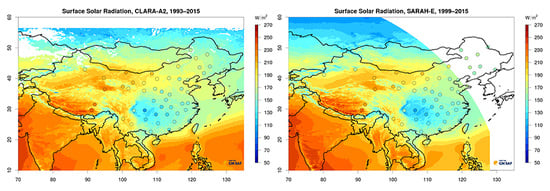Validation of CM SAF CLARA-A2 and SARAH-E Surface Solar Radiation Datasets over China
Abstract
1. Introduction
2. Datasets
2.1. The CLARA-A2 Dataset
2.2. The SARAH-E Dataset
2.3. The CMA Dataset
3. Methods
3.1. Data Quality Control
3.2. Validation Metrics and Procedure
4. Results and Discussion
4.1. Availability Test
4.2. Accuracy Test
4.3. Comparison of Trends from Satellite and Surface
5. Conclusions
Author Contributions
Funding
Acknowledgments
Conflicts of Interest
References
- Wild, M.; Folini, D.; Henschel, F.; Fischer, N.; Müller, B. Projections of long-term changes in solar radiation based on CMIP5 climate models and their influence on energy yields of photovoltaic systems. Sol. Energy 2015, 116, 12–24. [Google Scholar] [CrossRef]
- Wild, M.; Folini, D.; Schar, C.; Loeb, N.; Dutton, E.G.; Konig-Langlo, G. A New Diagram of the Global Energy Balance. Radiat. Process. Atmos. Ocean 2013, 1531, 628–631. [Google Scholar] [CrossRef]
- Wild, M. New Directions: A facelift for the picture of the global energy balance. Atmos. Environ. 2012, 55, 366–367. [Google Scholar] [CrossRef]
- Wild, M.; Liepert, B. The Earth radiation balance as driver of the global hydrological cycle. Environ. Res. Lett. 2010, 5, 025003. [Google Scholar] [CrossRef]
- Ohmura, A.; Wild, M. Is the hydrological cycle accelerating? Science 2002, 298, 1345–1346. [Google Scholar] [CrossRef] [PubMed]
- Mercado, L.M.; Bellouin, N.; Sitch, S.; Boucher, O.; Huntingford, C.; Wild, M.; Cox, P.M. Impact of changes in diffuse radiation on the global land carbon sink. Nature 2009, 458, U1014–U1087. [Google Scholar] [CrossRef] [PubMed]
- Wild, M.; Roesch, A.; Ammann, C. Global dimming and brightening—Evidence and agricultural implications. CAB Rev. 2012, 7, 1–7. [Google Scholar] [CrossRef]
- Wild, M.; Gilgen, H.; Roesch, A.; Ohmura, A.; Long, C.N.; Dutton, E.G.; Forgan, B.; Kallis, A.; Russak, V.; Tsvetkov, A. From dimming to brightening: Decadal changes in solar radiation at Earth’s surface. Science 2005, 308, 847–850. [Google Scholar] [CrossRef]
- Sanchez-Lorenzo, A.; Enriquez-Alonso, A.; Wild, M.; Trentmann, J.; Vicente-Serrano, S.M.; Sanchez-Romero, A.; Posselt, R.; Hakuba, M.Z. Trends in downward surface solar radiation from satellites and ground observations over Europe during 1983–2010. Remote Sens. Environ. 2017, 189, 108–117. [Google Scholar] [CrossRef]
- Pfeifroth, U.; Sanchez-Lorenzo, A.; Manara, V.; Trentmann, J.; Hollmann, R. Trends and Variability of Surface Solar Radiation in Europe based on Surface- and Satellite-based Data Records. J. Geophys. Res. Atmos. 2018, 123, 1735–1754. [Google Scholar] [CrossRef]
- Brinckmann, S.; Trentmann, J.; Ahrens, B. Homogeneity Analysis of the CM SAF Surface Solar Irradiance Dataset Derived from Geostationary Satellite Observations. Remote Sens. 2014, 6, 352–378. [Google Scholar] [CrossRef]
- Wang, Y.; Wild, M. A new look at solar dimming and brightening in China. Geophys. Res. Lett. 2016, 43, 11777–11785. [Google Scholar] [CrossRef]
- Wang, Y.; Wild, M.; Sanchez-Lorenzo, A.; Manara, V. Urbanization effect on trends in sunshine duration in China. Ann. Geophys. 2017, 35, 839–851. [Google Scholar] [CrossRef]
- Riihelä, A.; Carlund, T.; Trentmann, J.; Müller, R.; Lindfors, A. Validation of CM SAF Surface Solar Radiation Datasets over Finland and Sweden. Remote Sens. 2015, 7, 6663–6682. [Google Scholar] [CrossRef]
- Posselt, R.; Mueller, R.W.; Stöckli, R.; Trentmann, J. Remote sensing of solar surface radiation for climate monitoring—The CM-SAF retrieval in international comparison. Remote Sens. Environ. 2012, 118, 186–198. [Google Scholar] [CrossRef]
- Müller, R.; Pfeifroth, U.; Träger-Chatterjee, C.; Trentmann, J.; Cremer, R. Digging the METEOSAT Treasure—3 Decades of Solar Surface Radiation. Remote Sens. 2015, 7, 8067–8101. [Google Scholar] [CrossRef]
- Urraca, R.; Gracia-Amillo, A.M.; Koubli, E.; Huld, T.; Trentmann, J.; Riihelä, A.; Lindfors, A.V.; Palmer, D.; Gottschalg, R.; Antonanzas-Torres, F. Extensive validation of CM SAF surface radiation products over Europe. Remote Sens. Environ. 2017, 199, 171–186. [Google Scholar] [CrossRef] [PubMed]
- Polo, J.; Wilbert, S.; Ruiz-Arias, J.A.; Meyer, R.; Gueymard, C.; Suri, M.; Martin, L.; Mieslinger, T.; Blanc, P.; Grant, I. Preliminary survey on site-adaptation techniques for satellite-derived and reanalysis solar radiation datasets. Sol. Energy 2016, 132, 25–37. [Google Scholar] [CrossRef]
- Stackhouse, J.P.W.; Gupta, S.K.; Cox, S.J.; Zhang, T.; Mikovitz, J.C.; Hinkelman, L.M. The NASA/GEWEX surface radiation budget release 3.0: 24.5-year dataset. Gewex News 2011, 21, 10–12. [Google Scholar]
- Zhang, Y.C.; Long, C.N.; Rossow, W.B.; Dutton, E.G. Exploiting diurnal variations to evaluate the ISCCP-FD flux calculations and radiative-flux-analysis-processed surface observations from BSRN, ARM, and SURFRAD. J. Geophys. Res. Atmos. 2010, 115. [Google Scholar] [CrossRef]
- Huld, T.; Müller, R.; Gambardella, A. A new solar radiation database for estimating PV performance in Europe and Africa. Sol. Energy 2012, 86, 1803–1815. [Google Scholar] [CrossRef]
- Tang, W.; Qin, J.; Yang, K.; Liu, S.; Lu, N.; Niu, X. Retrieving high-resolution surface solar radiation with cloud parameters derived by combining MODIS and MTSAT data. Atmos. Chem. Phys. 2016, 16, 2543–2557. [Google Scholar] [CrossRef]
- Posselt, R.; Mueller, R.; Trentmann, J.; Stockli, R.; Liniger, M.A. A surface radiation climatology across two Meteosat satellite generations. Remote Sens. Environ. 2014, 142, 103–110. [Google Scholar] [CrossRef]
- Karlsson, K.-G.; Anttila, K.; Trentmann, J.; Stengel, M.; Meirink, J.F.; Devasthale, A.; Hanschmann, T.; Kothe, S.; Jääskeläinen, E.; Sedlar, J.; et al. CLARA-A2: The second edition of the CM SAF cloud and radiation data record from 34 years of global AVHRR data. Atmos. Chem. Phys. 2017, 17, 5809–5828. [Google Scholar] [CrossRef]
- Sanchez-Lorenzo, A.; Wild, M.; Trentmann, J. Validation and stability assessment of the monthly mean CM SAF surface solar radiation dataset over Europe against a homogenized surface dataset (1983–2005). Remote Sens. Environ. 2013, 134, 355–366. [Google Scholar] [CrossRef]
- Alexandri, G.; Georgoulias, A.K.; Meleti, C.; Balis, D.; Kourtidis, K.A.; Sanchez-Lorenzo, A.; Trentmann, J.; Zanis, P. A high resolution satellite view of surface solar radiation over the climatically sensitive region of Eastern Mediterranean. Atmos. Res. 2017, 188, 107–121. [Google Scholar] [CrossRef]
- Riihelä, A.; Kallio, V.; Devraj, S.; Sharma, A.; Lindfors, A. Validation of the SARAH-E Satellite-Based Surface Solar Radiation Estimates over India. Remote Sens. 2018, 10, 392. [Google Scholar] [CrossRef]
- Wu, F.; Fu, C. Assessment of GEWEX/SRB version 3.0 monthly global radiation dataset over China. Meteorol. Atmos. Phys. 2011, 112, 155. [Google Scholar] [CrossRef]
- Hayasaka, T.; Kawamoto, K.; Shi, G.; Ohmura, A. Importance of aerosols in satellite-derived estimates of surface shortwave irradiance over China. Geophys. Res. Lett. 2006, 33, L06802. [Google Scholar] [CrossRef]
- Xia, X.A.; Wang, P.C.; Chen, H.B.; Liang, F. Analysis of downwelling surface solar radiation in China from National Centers for Environmental Prediction reanalysis, satellite estimates, and surface observations. J. Geophys. Res. Atmos. 2006, 111, 2105–2117. [Google Scholar] [CrossRef]
- Jia, B.; Xie, Z.; Dai, A.; Shi, C.; Chen, F. Evaluation of satellite and reanalysis products of downward surface solar radiation over East Asia: Spatial and seasonal variations. J. Geophys. Res. Atmos. 2013, 118, 3431–3446. [Google Scholar] [CrossRef]
- Yang, K.; Toshio, K.; Paul, S.; Colleen, M.; Stephen, J.C. An assessment of satellite surface radiation products for highlands with Tibet instrumental data. Geophys. Res. Lett. 2006, 33, L22403. [Google Scholar] [CrossRef]
- Yang, K.; Pinker, R.T.; Ma, Y.; Koike, T.; Wonsick, M.M.; Cox, S.J.; Zhang, Y.; Stackhouse, P. Evaluation of satellite estimates of downward shortwave radiation over the Tibetan Plateau. J. Geophys. Res. Atmos. 2008, 113, D17204. [Google Scholar] [CrossRef]
- Karlsson, K.-G.; Anttila, K.; Trentmann, J.; Stengel, M.; Meirink, J.F.; Devasthale, A.; Hanschmann, T.; Kothe, S.; Jääskeläinen, E.; Sedlar, J.; et al. CLARA-A2: CM SAF cLoud, Albedo and Surface RAdiation Dataset from AVHRR Data—Edition 2. Satell. Appl. Facil. Clim. Monit. 2017. [Google Scholar] [CrossRef]
- Mueller, R.W.; Matsoukas, C.; Gratzki, A.; Behr, H.D.; Hollmann, R. The CM-SAF operational scheme for the satellite based retrieval of solar surface irradiance—A LUT based eigenvector hybrid approach. Remote Sens. Environ. 2009, 113, 1012–1024. [Google Scholar] [CrossRef]
- Karlsson, K.G.; Riihel, A.; Müller, R.; Meirink, J.F. CLARA-A1: The CM SAF cloud, albedo and radiation dataset from 28 yr of global AVHRR data. Atmos. Chem. Phys. 2013, 13, 5351–5367. [Google Scholar] [CrossRef]
- Huld, T.; Müller, R.; Gracia-Amillo, A.; Pfeifroth, U.; Trentmann, J. Surface Solar Radiation Data Set- Heliosat, Meteosat-East (SARAH-E)- Edition 1.1. Satell. Appl. Facil. Clim. Monit. 2017. [Google Scholar] [CrossRef]
- Gracia Amillo, A.; Huld, T.; Müller, R. A New Database of Global and Direct Solar Radiation Using the Eastern Meteosat Satellite, Models and Validation. Remote Sens. 2014, 6, 8165–8189. [Google Scholar] [CrossRef]
- Wang, K.; Ma, Q.; Li, Z.; Wang, J. Decadal variability of surface incident solar radiation over China: Observations, satellite retrievals, and reanalyses. J. Geophys. Res. Atmos. 2015, 120, 6500–6514. [Google Scholar] [CrossRef]
- Yang, S.; Wang, X.L.; Wild, M. Homogenization and Trend Analysis of the 1958–2016 In Situ Surface Solar Radiation Records in China. J. Clim. 2018, 31, 4529–4541. [Google Scholar] [CrossRef]
- Yang, Y.; Ding, L.; Quan, J.; Cheng, X. Uncertainty Analysis of Calibration Results of Homemade Pyranometers. Meteorol. Sci. Technol. 2012, 40, 20–24. [Google Scholar]
- Shi, G.; Hayasaka, T.; Ohmura, A.; Chen, Z.; Wang, B.; Zhao, J.; Che, H.; Xu, L. Data quality assessment and the long-term trend of ground solar radiation in China. Anglais 2008, 47, 1006–1016. [Google Scholar] [CrossRef]
- Tang, W.; Yang, K.; He, J.; Qin, J. Quality control and estimation of global solar radiation in China. Sol. Energy 2010, 84, 466–475. [Google Scholar] [CrossRef]
- Allen, R.G.; Pereira, L.S.; Raes, D.; Smith, M. Crop Evapotranspiration—Guidelines for Computing Crop Water Requirements—FAO Irrigation and Drainage Paper 56; FAO: Rome, Italy, 1998. [Google Scholar]
- Alexandersson, H. A homogeneity test applied to precipitation data. Int. J. Clim. 1986, 6, 661–675. [Google Scholar] [CrossRef]
- Khaliq, M.N.; Ouarda, T.B.M.J. On the critical values of the standard normal homogeneity test (SNHT). Int. J. Clim. 2007, 27, 681–687. [Google Scholar] [CrossRef]
- Pontius, R.G.; Thontteh, O.; Chen, H. Components of information for multiple resolution comparison between maps that share a real variable. Environ. Ecol. Stat. 2008, 15, 111–142. [Google Scholar] [CrossRef]
- Driemel, A.; Augustine, J.; Behrens, K.; Colle, S.; Cox, C.; Cuevas-Agulló, E.; Denn, F.M.; Duprat, T.; Fukuda, M.; Grobe, H. Baseline Surface Radiation Network (BSRN): Structure and data description (1992–2017). Earth Syst. Sci. Data 2018, 10, 1491–1501. [Google Scholar] [CrossRef]
- Zhang, X.; Liang, S.; Wild, M.; Jiang, B. Analysis of surface incident shortwave radiation from four satellite products. Remote Sens. Environ. 2015, 165, 186–202. [Google Scholar] [CrossRef]
- Chan, C.K.; Yao, X. Air pollution in mega cities in China. Atmos. Environ. 2008, 42, 1–42. [Google Scholar] [CrossRef]
- Qiu, X.; Zeng, Y.; Miao, Q. Temporal-spatial Distribution as well as Tracks and Source Areas of Sand-Dust Storms in China. Acta Geogr. Sin. 2001, 56, 316–322. [Google Scholar]
- Zhang, D.; Wang, Y.; Feng, Y.; Fang, Y. Analysis and Forecasting of High-Humidity Weather in Guangdong in February and March. Meteorol. Sci. Technol. 2014, 42, 302–308. [Google Scholar]
- Qu, W.J.; Arimoto, R.; Zhang, X.Y.; Zhao, C.H.; Wang, Y.Q.; Sheng, L.F.; Fu, G. Spatial distribution and interannual variation of surface PM(10) concentrations over eighty-six Chinese cities. Atmos. Chem. Phys. 2010, 10, 5641–5662. [Google Scholar] [CrossRef]
- Dürr, B.; Zelenka, A.; Müller, R.; Philipona, R. Verification of CM-SAF and MeteoSwiss satellite based retrievals of surface shortwave irradiance over the Alpine region. Int. J. Remote Sens. 2010, 31, 4179–4198. [Google Scholar] [CrossRef]
- Imamovic, A.; Tanaka, K.; Folini, D.; Wild, M. Global dimming and urbanization: Did stronger negative SSR trends collocate with regions of population growth? Atmos. Chem. Phys. 2016, 16, 2719–2725. [Google Scholar] [CrossRef]
- Wang, K.; Ye, H.; Chen, F.; Xiong, Y.; Wang, C. Urbanization effect on the diurnal temperature range: Different roles under solar dimming and brightening. J. Clim. 2012, 25, 1022–1027. [Google Scholar] [CrossRef]
- Lin, C.Q.; Liu, G.; Lau, A.K.H.; Li, Y.; Li, C.C.; Fung, J.C.H.; Lao, X.Q. High-resolution satellite remote sensing of provincial PM2.5 trends in China from 2001 to 2015. Atmos. Environ. 2018, 180, 110–116. [Google Scholar] [CrossRef]
- Tang, W.J.; Yang, K.; Qin, J.; Cheng, C.C.K.; He, J. Solar radiation trend across China in recent decades: A revisit with quality-controlled data. Atmos. Chem. Phys. 2011, 11, 393–406. [Google Scholar] [CrossRef]
- Ryu, Y.; Jiang, C.; Kobayashi, H.; Detto, M. MODIS-derived global land products of shortwave radiation and diffuse and total photosynthetically active radiation at 5km resolution from 2000. Remote Sens. Environ. 2018, 204, 812–825. [Google Scholar] [CrossRef]
- Wang, Y.W.; Yang, Y.H. China’s dimming and brightening: Evidence, causes and hydrological implications. Ann. Geophys. 2014, 32, 41–55. [Google Scholar] [CrossRef]
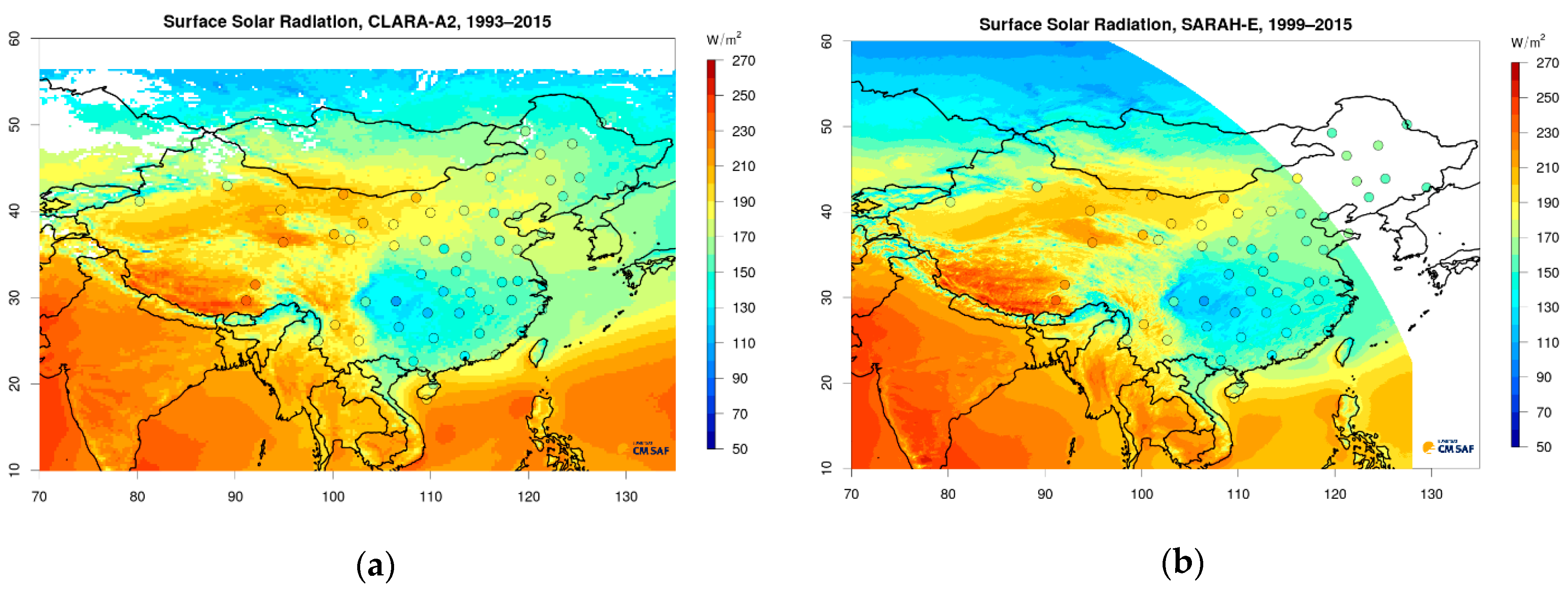

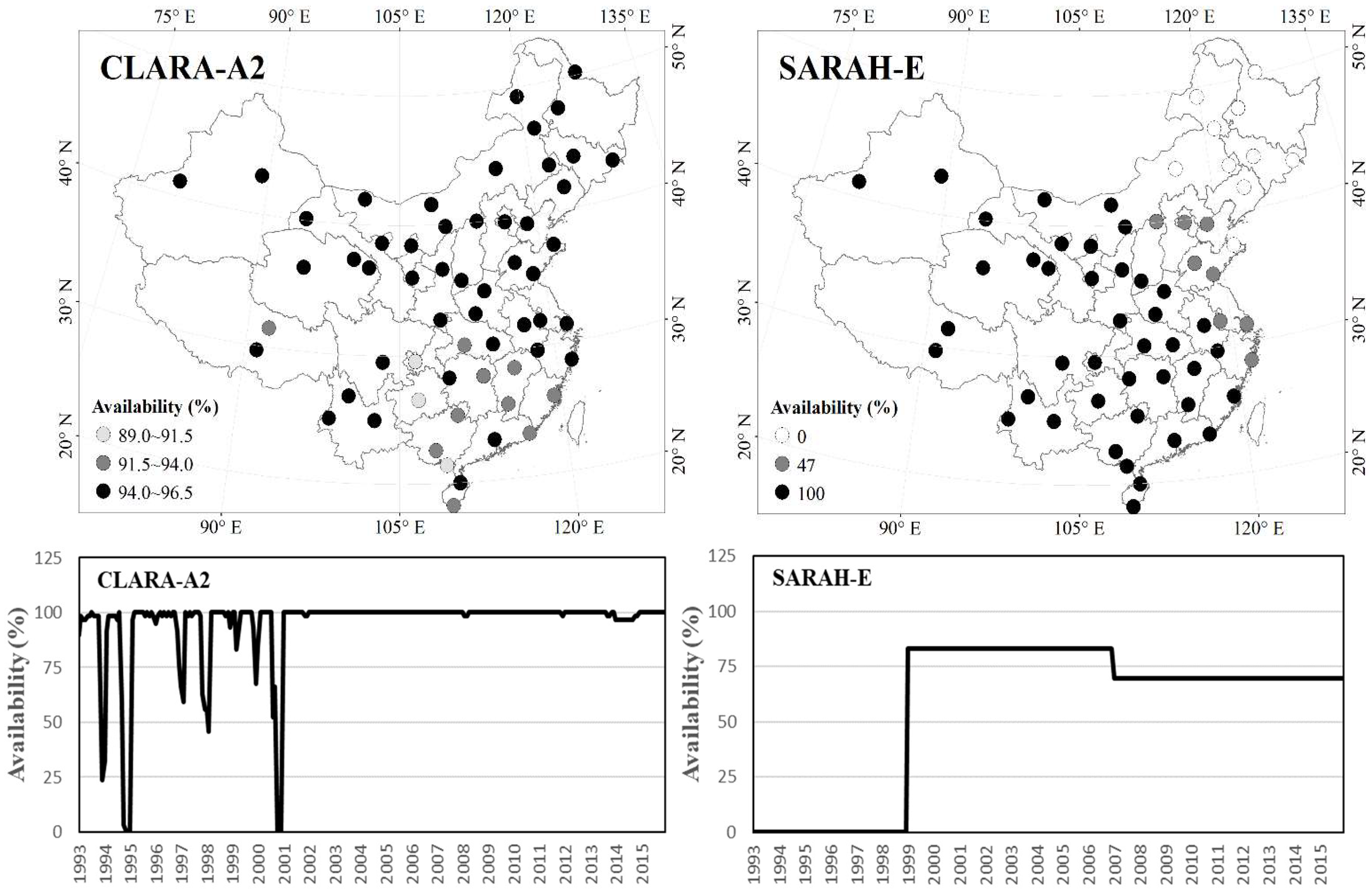
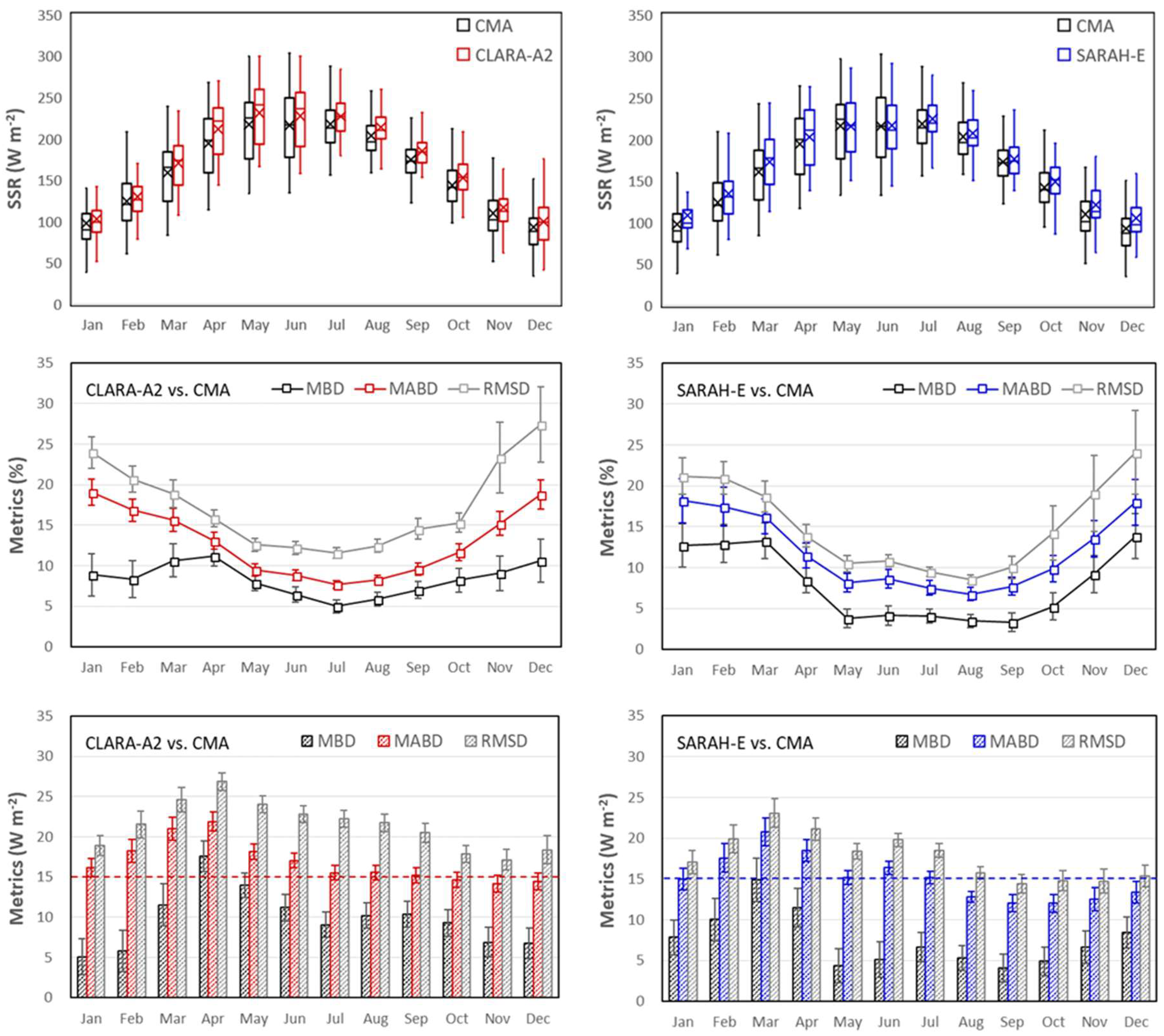
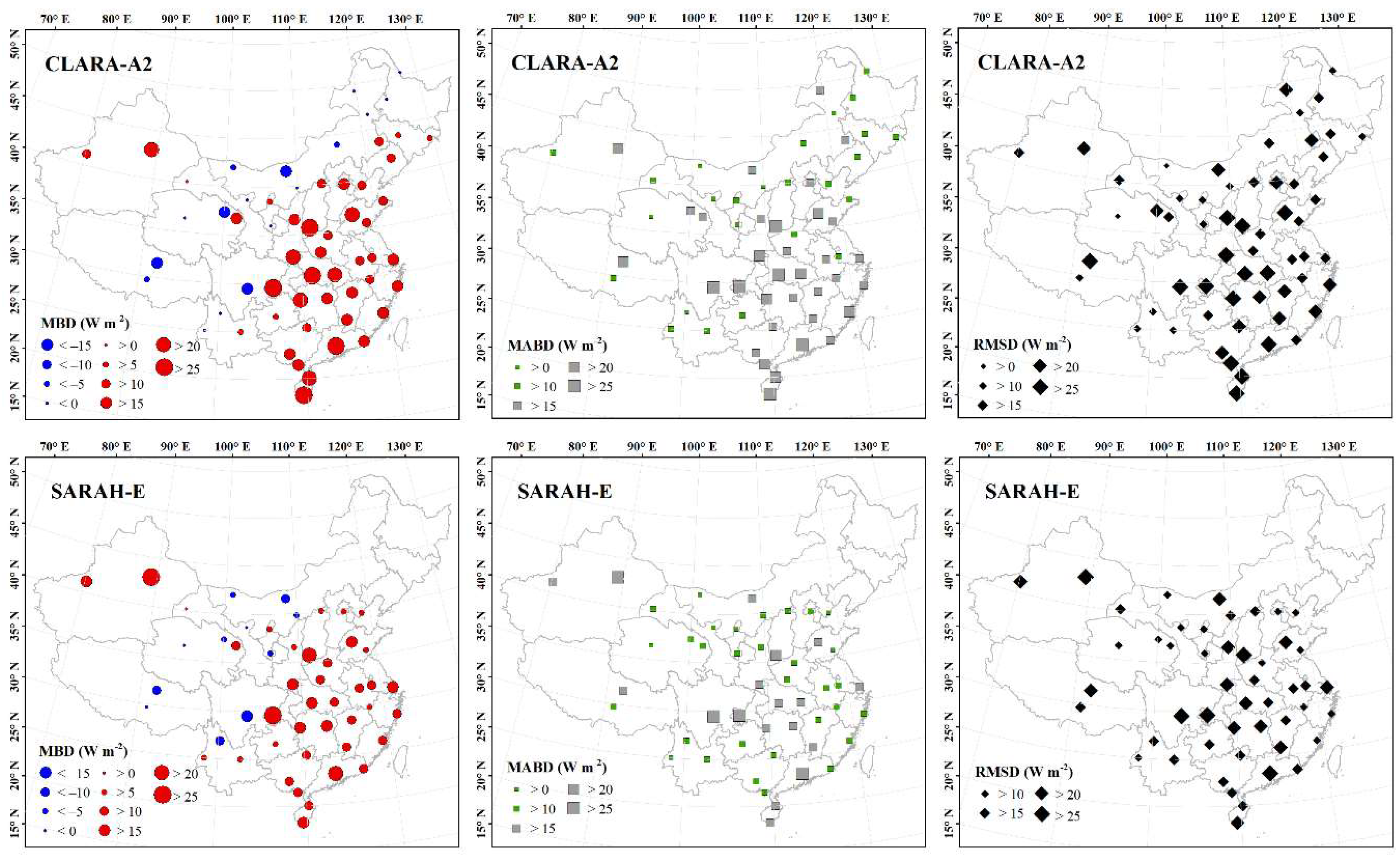

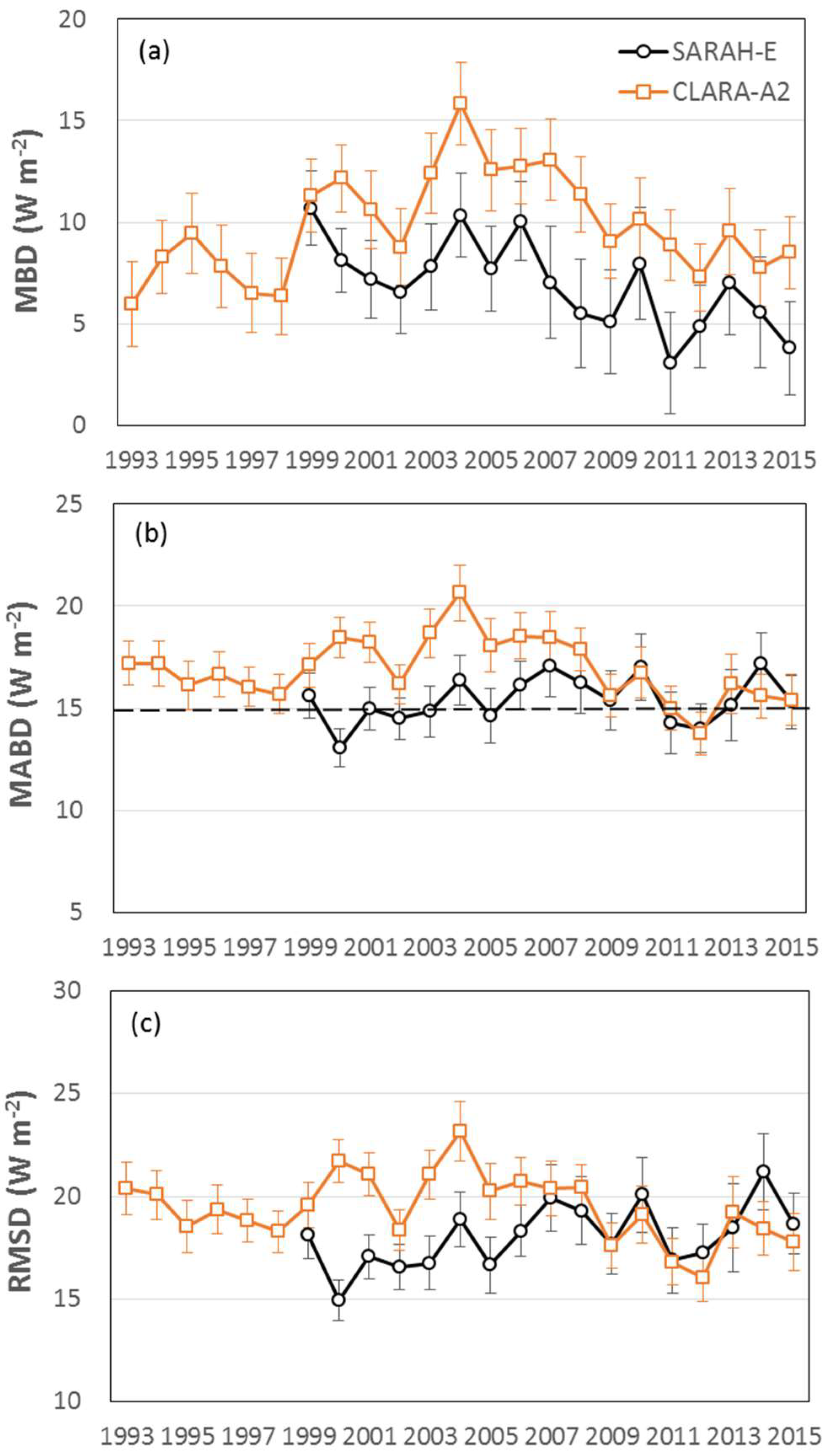
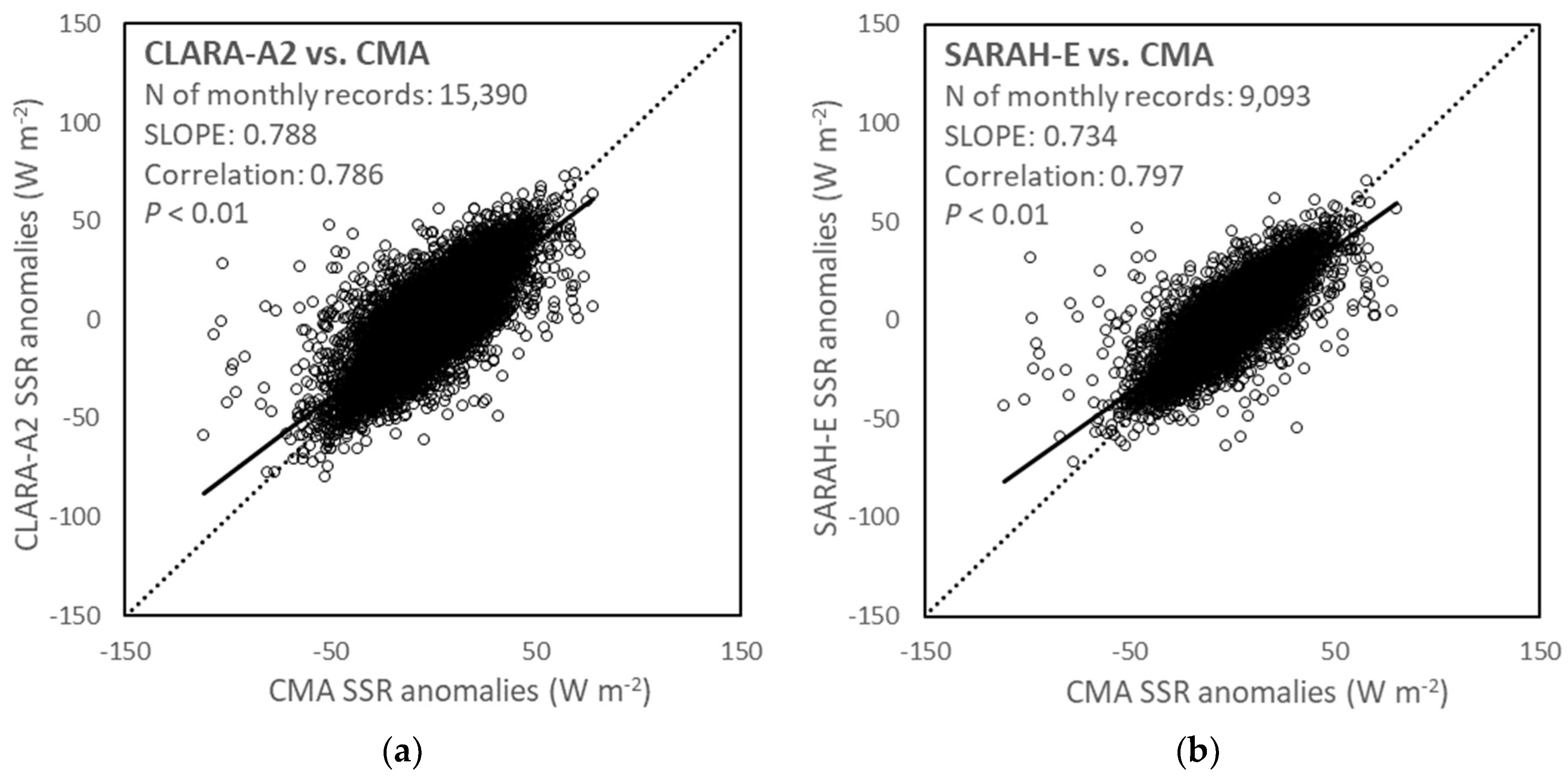
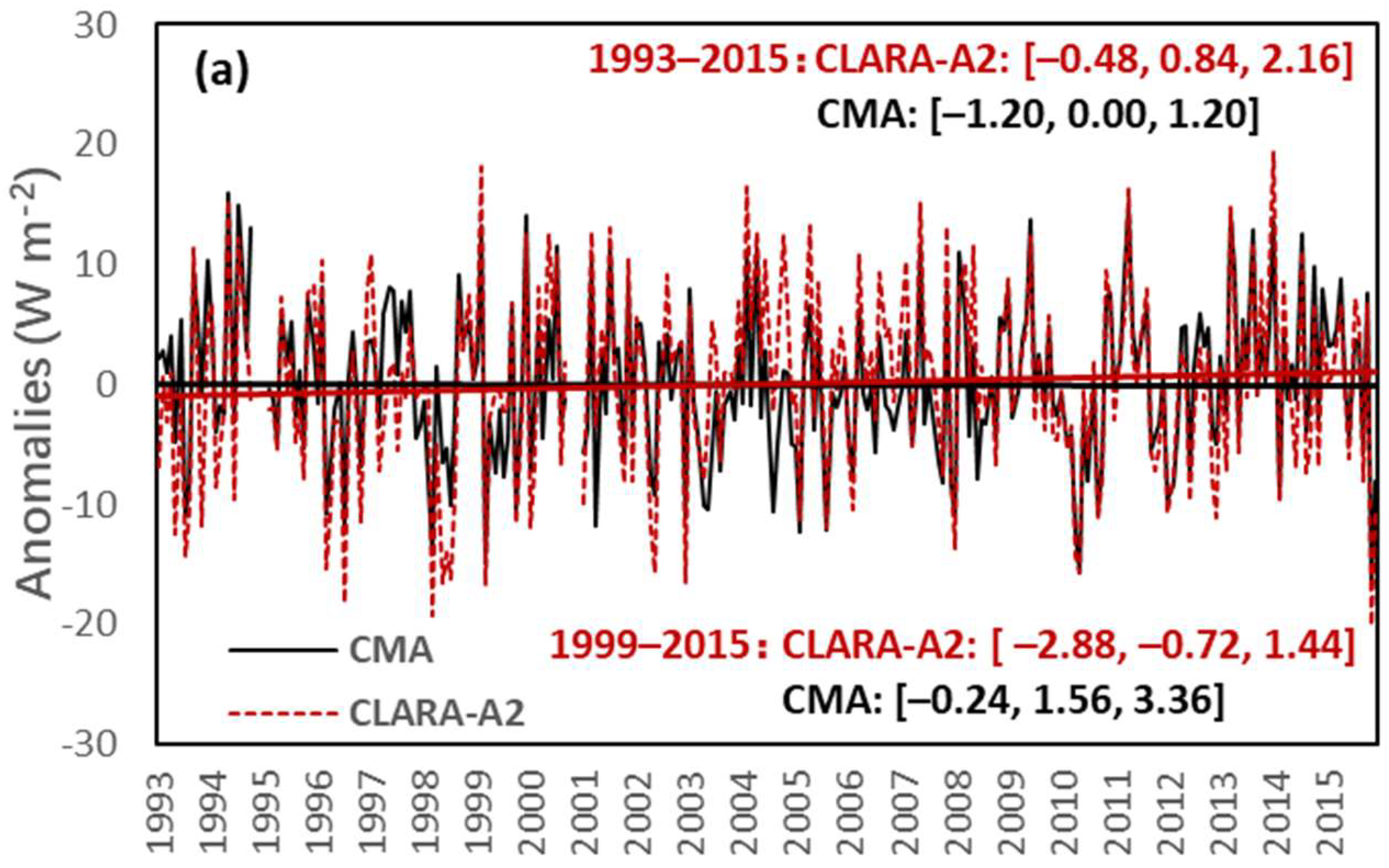
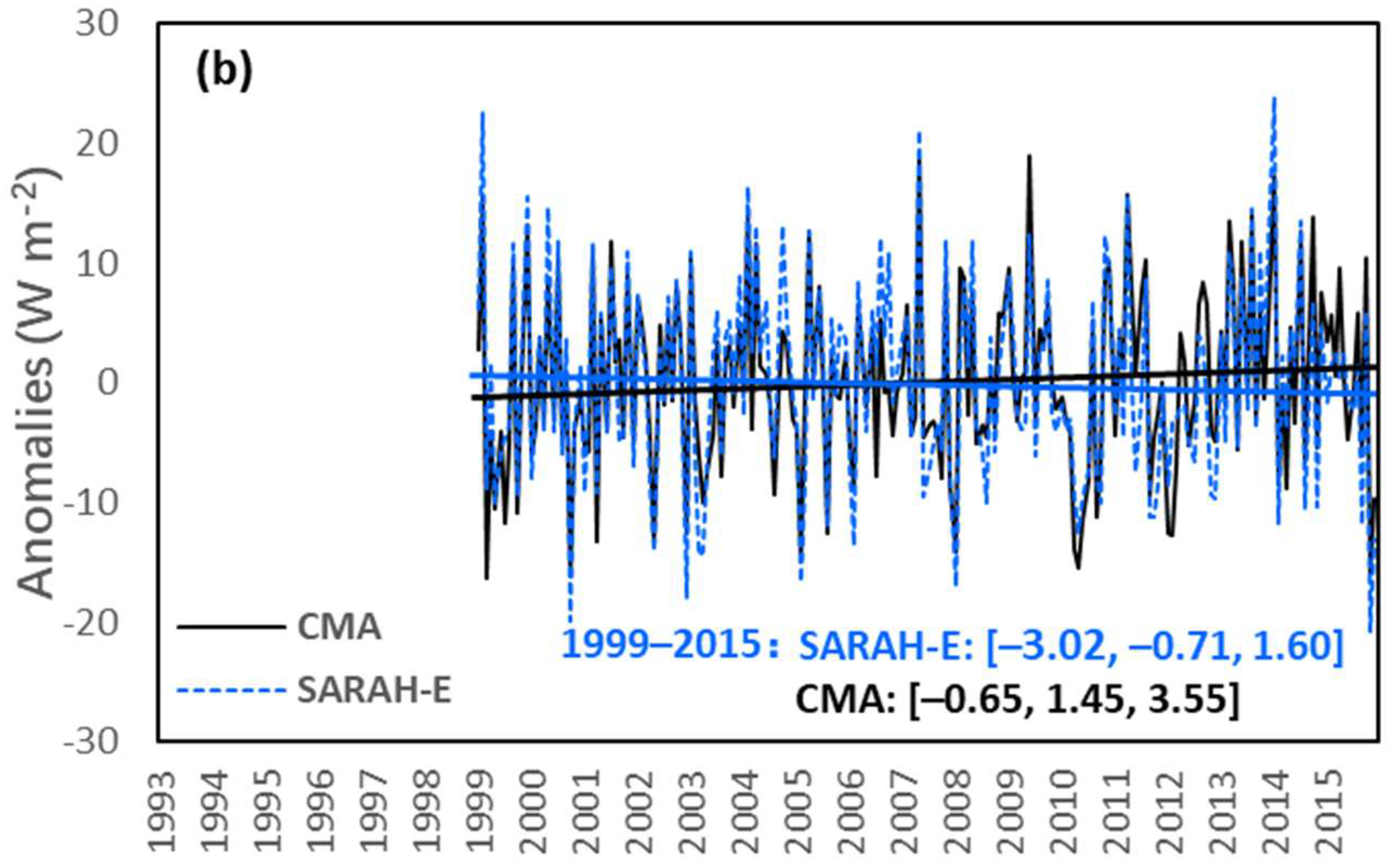
| Products | Resolution | Coverage | Reference | ||
|---|---|---|---|---|---|
| Temporal | Spatial | Temporal | Spatial | ||
| CLARA-A2 | daily/monthly | 0.25° × 0.25° | 1982–2015 | Global | [24] |
| SARAH-E | Hourly/daily/monthly | 0.05° × 0.05° | 1999–2016 | ±65° lat., 8°W to 128°E | [28] |
| GEWEX-SRB V3.0 | 3-hourly/daily/monthly | 1° × 1° | 1983–2007 | Global | [19] |
| ISCCP-FD | 3-hourly/monthly | 2.5° × 2.5° | 1983–2007 | Global | [20] |
| CERES-EBAF Ed2.7 | monthly | 1° × 1° | 2000–2013 | Global | [29] |
| UMD-SRB V3.3.3 | monthly | 0.5° × 0.5° | 1983–2007 | Global | [29] |
| MBD | MABD | RMSD | ||||
|---|---|---|---|---|---|---|
| W m−2 | % | W m−2 | % | W m−2 | % | |
| CLARA-A2 | ||||||
| Annual | 10.0 ± 1.7 | 8.2 ± 1.4 | 16.9 ± 0.9 | 12.6 ± 0.9 | 20.5 ± 0.9 | 17.7 ± 1.8 |
| MAM | 14.4 ± 1.2 | 9.9 ± 0.9 | 20.3 ± 0.7 | 12.7 ± 0.7 | 23.2 ± 0.7 | 14.9 ± 0.7 |
| JJA | 10.2 ± 0.9 | 5.7 ± 0.5 | 16.1 ± 0.5 | 8.2 ± 0.3 | 19.3 ± 0.5 | 10.1 ± 0.4 |
| SON | 8.9 ± 1.0 | 8.1 ± 0.9 | 14.7 ± 0.6 | 12.1 ± 0.7 | 17.2 ± 0.6 | 16.1 ± 1.6 |
| DJF | 5.9 ± 1.3 | 9.3 ± 1.5 | 16.3 ± 0.7 | 18.2 ± 0.9 | 18.6 ± 0.7 | 22.1 ± 1.6 |
| SARAH-E | ||||||
| Annual | 7.5 ± 1.9 | 7.9 ± 1.5 | 15.1 ± 1.0 | 12.0 ± 1.0 | 18.7 ± 1.0 | 18.1 ± 2.2 |
| MAM | 10.3 ± 1.4 | 8.5 ± 1.0 | 18.2 ± 0.8 | 12.0 ± 0.8 | 20.9 ± 0.8 | 14.4 ± 0.9 |
| JJA | 5.7 ± 1.1 | 3.9 ± 0.6 | 14.8 ± 0.4 | 7.7 ± 0.3 | 18.0 ± 0.5 | 9.6 ± 0.4 |
| SON | 5.2 ± 1.1 | 5.9 ± 1.0 | 12.2 ± 0.7 | 10.4 ± 0.8 | 14.7 ± 0.7 | 14.5 ± 2.0 |
| DJF | 8.8 ± 1.3 | 13.2 ± 1.5 | 15.3 ± 0.9 | 17.9 ± 1.2 | 17.5 ± 0.9 | 22.1 ± 2.0 |
| MBD | MABD | RMSD | ||||
|---|---|---|---|---|---|---|
| W m−2 | % | W m−2 | % | W m−2 | % | |
| CLARA-A2 | ||||||
| 51 Urban | 11.9 ± 1.7 | 9.7 ± 1.5 | 17.6 ± 0.9 | 13.4 ± 1.0 | 21.1 ± 1.0 | 18.8 ± 2.0 |
| 8 Rural | −2.1 ± 4.1 | −1.3 ± 2.5 | 12.5 ± 1.4 | 7.8 ± 0.8 | 16.0 ± 1.7 | 10.5 ± 1.0 |
| 8 Nearby Urban | 10.0 ± 3.3 | 5.8 ± 2.5 | 15.5 ± 1.8 | 10.1 ± 1.5 | 19.8 ± 1.6 | 13.0 ± 1.6 |
| SARAH-E | ||||||
| 43 Urban | 9.0 ± 2.0 | 9.1 ± 1.6 | 15.8 ± 1.1 | 12.8 ± 1.1 | 19.3 ± 1.1 | 19.5 ± 2.5 |
| 6 Rural | −3.2 ± 3.7 | −0.7 ± 2.2 | 10.5 ± 1.3 | 6.1 ± 0.7 | 13.8 ± 1.8 | 8.1 ± 1.0 |
| 6 Nearby Urban | 6.3 ± 3.3 | 5.1 ± 2.2 | 11.7 ± 1.1 | 7.8 ± 1.1 | 15.3 ± 1.3 | 10.3 ± 1.2 |
© 2018 by the authors. Licensee MDPI, Basel, Switzerland. This article is an open access article distributed under the terms and conditions of the Creative Commons Attribution (CC BY) license (http://creativecommons.org/licenses/by/4.0/).
Share and Cite
Wang, Y.; Trentmann, J.; Yuan, W.; Wild, M. Validation of CM SAF CLARA-A2 and SARAH-E Surface Solar Radiation Datasets over China. Remote Sens. 2018, 10, 1977. https://doi.org/10.3390/rs10121977
Wang Y, Trentmann J, Yuan W, Wild M. Validation of CM SAF CLARA-A2 and SARAH-E Surface Solar Radiation Datasets over China. Remote Sensing. 2018; 10(12):1977. https://doi.org/10.3390/rs10121977
Chicago/Turabian StyleWang, Yawen, Jörg Trentmann, Wenping Yuan, and Martin Wild. 2018. "Validation of CM SAF CLARA-A2 and SARAH-E Surface Solar Radiation Datasets over China" Remote Sensing 10, no. 12: 1977. https://doi.org/10.3390/rs10121977
APA StyleWang, Y., Trentmann, J., Yuan, W., & Wild, M. (2018). Validation of CM SAF CLARA-A2 and SARAH-E Surface Solar Radiation Datasets over China. Remote Sensing, 10(12), 1977. https://doi.org/10.3390/rs10121977





